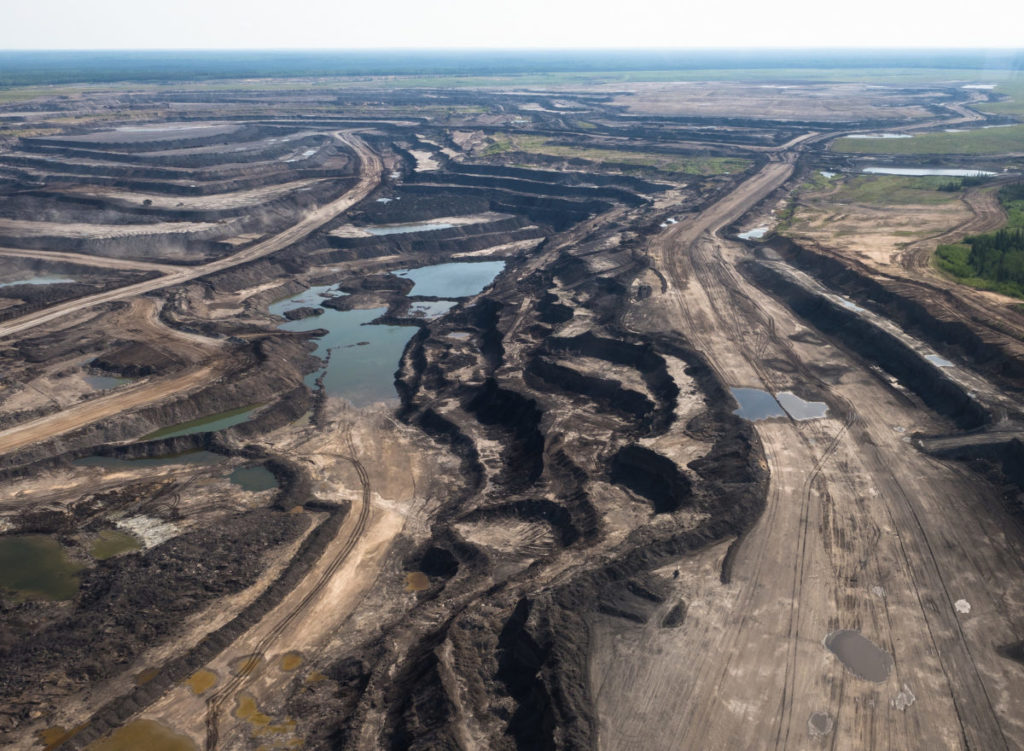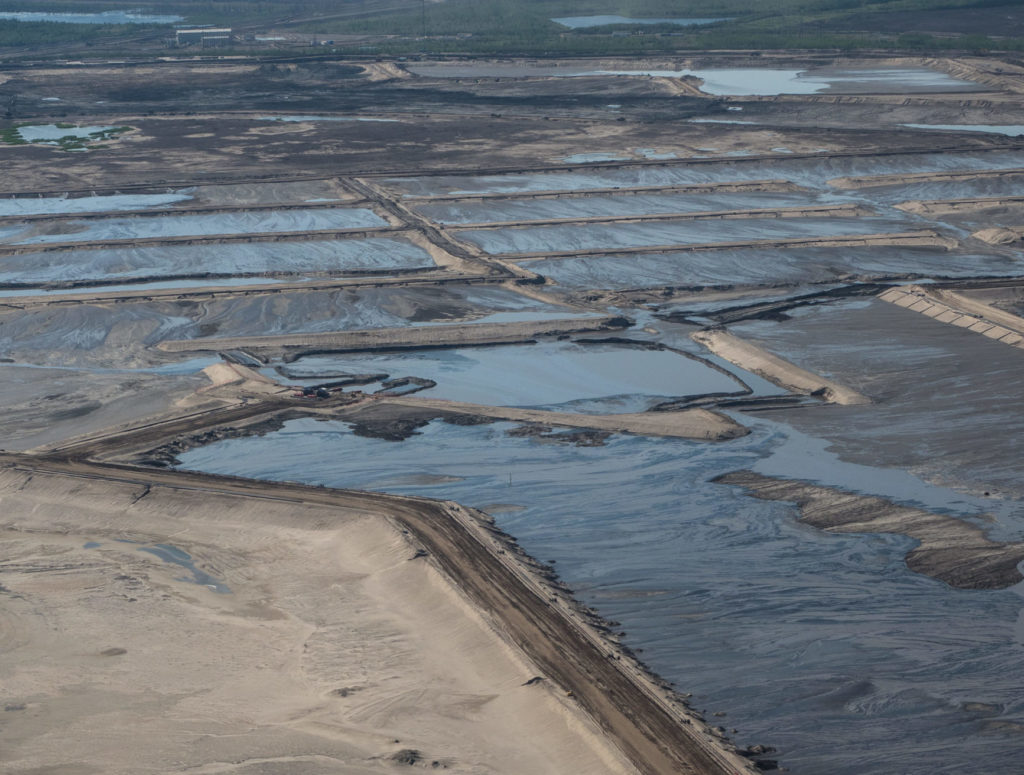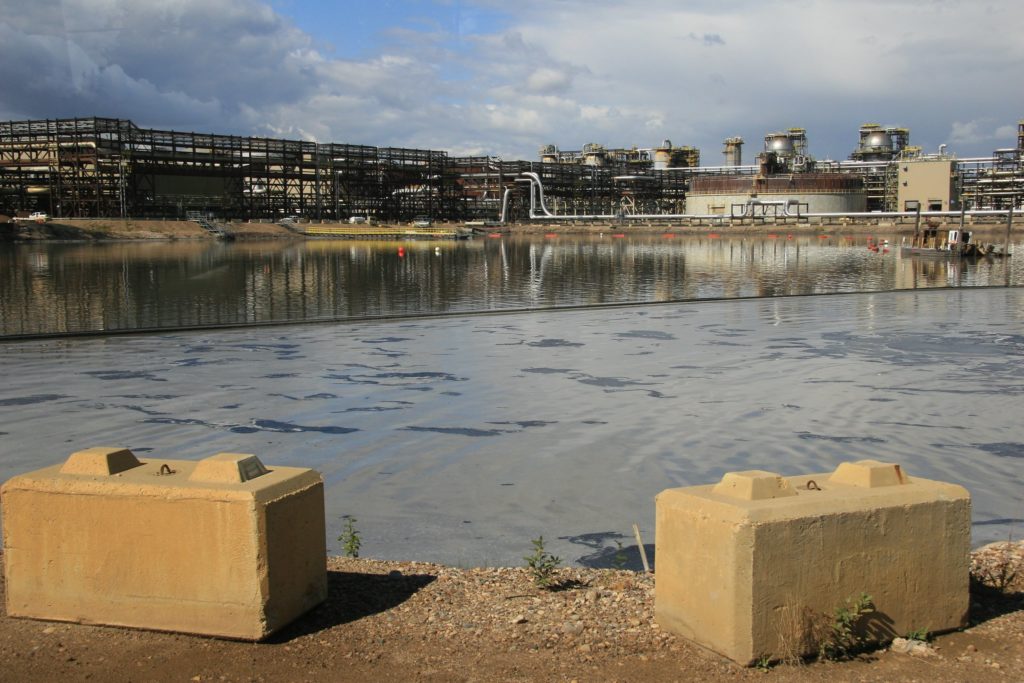
Hope for a huge, ancient and imperilled fish
First Nations are leading efforts to make sure lake sturgeon can find a home in...
As Alberta doles out $1 billion in federal money to ensure oil and gas wells across the province are safely sealed and eventually cleaned up, we started wondering about the elephant in the room: the cleanup of the oilsands.
While the liabilities associated with oil and gas wells are substantial, there are more cleanup costs on the horizon.
The oilsands industry has been hit hard in recent months, with a global supply glut and reduced demand as a result of the COVID-19 pandemic. For a while, oil prices were even negative.
But the pressures on the oilsands have been ongoing for several years now, and low commodity prices have led to questions about the long-term profitability of the industry.
At the end of the day, all those mines (and their tailings ponds) legally have to be cleaned up. The big question is: who’s going to end up paying for it?
Read on.
The Alberta Energy Regulator tracks the estimated cost of reclaiming coal and oilsands mines in the province using its
mine financial security program, based on figures submitted by industry.
A spokesperson for the regulator confirmed in November 2020 that the most recent estimate of total liabilities associated with oilsands mines in that program is $30.81 billion.
But not everyone is confident these estimates fully capture the cost of cleanup once the resources are tapped.
“It’s almost impossible to [estimate the liabilities] because no one has a clear sense of what it’s going to cost,” Martin Olszynski, an associate professor of law at the University of Calgary, told The Narwhal. “It’s never been done before.”
And then there’s the risk the cleanup technologies oilsands companies are betting on won’t work.
“It’s really difficult to know whether those estimates reflect the risk of things not performing as expected,” Nina Lothian, the director of the fossil fuel program of the Pembina Institute, told The Narwhal.
And, as has been frequently reported, even senior staff within the regulator’s office have had their doubts.
In 2018, a team of journalists working on the Price of Oil series revealed internal documents from the Alberta Energy Regulator that pegged the
total liabilities of mining to be $130 billion — far higher than the figures the regulator had long been sharing with the public.
Facing public outcry, the regulator attempted to distance itself from its internal estimates, saying the figures “were based on a hypothetical worst-case scenario.”
Those same internal documents showed the estimated tab for the total cleanup of the industry to be $260 billion, once wells and pipelines were added to the equation.
In theory, the mine financial security program, essentially a deposit system administered by the Alberta Energy Regulator, is supposed to ensure that companies put aside funds to pay for cleanup down the road.
But according to figures a spokesperson for the regulator confirmed to The Narwhal, the amount currently held in deposits is nowhere near the total cost.
As of September 2020, the most recent data available, the regulator held $939 million in securities from oilsands mining companies.
That’s just three per cent of the industry-generated estimates of total liabilities associated with the oilsands — and less than one per cent of the internally estimated liabilities.
Other jurisdictions have moved to avoid this potential cash shortfall in the long term. Both Quebec and Yukon, for example, require mine operators to set aside money for cleanup in full prior to getting started.
In Alberta, the base deposit required ranges from $30 to $60 million. For comparison, the recently scrapped proposal to build the Teck Frontier mine pegged the cost at $20 billion. That would add up to a deposit worth approximately 0.1 per cent of the cost to build the new mine.
Oilsands mines are the huge, strip-mined swaths in the boreal forest for which Alberta’s energy industry has become widely known.
They account for 97 per cent of Canada’s proven oil reserves, according to Natural Resources Canada.
The oil produced there also makes up the majority of Canada’s total oil production — 63 per cent in 2019, or 2.95 million barrels per day.
But not all oil from the oilsands comes from the open-pit mines that everyone has seen photos of (even from space). Open-pit mining accounts for half of production. The rest comes from something known as in-situ production, which involves injecting steam deep into the ground via wells.
There are seven oilsands mines operating in northern Alberta right now. According to the Canadian Association of Petroleum Producers, the active mining areas of these sites combined is around 1,030 square kilometres — roughly the size of the City of Calgary.
Cleaning up those seven mines is what could amount to $130 billion.

Open-pit mining in the Alberta oilsands requires digging up boreal forest in order to extract vast quantities of bitumen. Photo: Louis Bockner / Sierra Club BC
Two words: tailings ponds.
“The tailings problem is the most pernicious and the most difficult,” Olszynski told The Narwhal. “The water issues are the main hurdle.”
Canada’s Ecofiscal Commission, founded by a group of Canadian economists, concluded in July 2018 that “tailings from oilsands represent the province’s largest environmental liability.”
The tailings ponds in Alberta’s oilsands are huge, spanning some 220 square kilometres total, nearly twice the size of Vancouver. So far, more than a trillion litres of tailings — a mixture of waste water, clay, sand and petrochemical residues — have been stored in them.
The mixture in tailings ponds can be highly toxic, and has been known to contain arsenic, benzene, lead and mercury.
Environmental Defence advocates against the creation of any new tailings ponds in the oilsands “until industry successfully demonstrates that it is capable of properly reclaiming them.”
And therein lies the problem, according to experts.

Tailings ponds in Alberta’s oilsands. Louis Bockner / Sierra Club BC
Two words come up time and time again when talking about technologies to reclaim tailings ponds, whether it’s from concerned stakeholders, scientists or the regulator itself: “unproven” and “unknown.”
“We haven’t figured out solutions today that we’re confident are going to create landscapes that are going to be self-sufficient and self-sustaining tomorrow,” Lothian of the Pembina Institute, told The Narwhal.
Currently, one preferred technology is known as water capping. In this method, tailings are pumped into an old mine pit and “capped” with a layer of fresh water to create an artificial lake. The idea is that the heavier tailings are trapped deep below the surface of the freshwater.
“It’s got some long-term unknowns about what happens to the quality of your water cap [and] could those tailings become resuspended and contaminate the water,” Lothian said.
Syncrude, one of the major players in the oilsands, says on its website that water capping results in lakes that “will evolve into natural ecosystems and, over time, support healthy communities of aquatic plants, animals and fish.”
“There has been a lot of investment … a lot of smart people are trying to figure out this challenge,” Lothian added.“There are just a lot of unknowns about the performance of tailings treatment over time.”
Syncrude’s first attempt, Base Mine Lake, was created in 2012. The project involves 20 years of monitoring “to demonstrate that the lake is developing into a viable ecosystem and to prove that this technology can be used on other oilsands leases,” according to the company.
But not everyone is so optimistic the technology will pan out — and many have raised concerns that other technologies might end up being even costlier.
Olszynski calls it “super experimental.”
“Frankly, it’s very hard to get a very sober objective analysis of how [Syncrude’s Base Mine Lake] is doing and whether it will succeed,” he said.
“We need a sober assessment of what exactly are the prospects for any kind of innovation: What are the costs? What are the alternatives? What’s the backup plan?” he said.
“There’s no guarantee that they’ll figure it out.”

Residual bitumen on a wastewater pond at a tailings treatment plant at the Shell Albian Sands site in 2014. Photo: Julia Kilpatrick / Pembina Institute.
For years, the oilsands industry was riding on a high, so to speak, in the wake of the $100-per-barrel oil prices seen six years ago.
But those prices haven’t been around for a while. Prices sunk dramatically, even reaching negative prices in April, though they have since increased. These lows were not something the industry had been forecasting.
One can look to the (now-abandoned) Teck Frontier oilsands mine proposal for a sense of the industry’s optimism in the not-so-distant past.
In projections for the project, the company used “an average long-term real oil price of US$95 per barrel for West Texas Intermediate” — a price not seen since 2014 — to calculate its base case for the economic impact of the project.
“Prices are forecast to be US$80 to US$90 per barrel by 2020, and increasing thereafter,” Teck had written in a 2016 submission.
We’re in strange times now, what with the impacts of the novel coronavirus and a global supply glut, but even before these forces hammered oil markets, the industry was dealing with lower prices and projections that they would only decrease further in the long run.
In its 2020 budget, for example, the Alberta government projected prices of US$58 per barrel for West Texas Intermediate, far below the expectations laid out by Teck.
That raises questions for Olszynski about whether the industry will be bringing in enough money in the long run to pay for its cleanup.
“They’ve backended all of their liabilities,” he said. “They have massive multibillion-dollar liabilities — you know, at least $30-billion and possibly as high as $100-billion liabilities — that they have essentially, through the regulatory process, backloaded to when they are potentially facing a declining market.”
Amid news of international investors pulling out of the oilsands citing climate change concerns, some are also starting to note the industry’s substantial long-term liabilities.
Earlier this year, SHARE, a not-for-profit investment service group that works with endowment funds, institutional investors and pension funds, published an investor brief outlining the risks associated with environmental liabilities in the oilsands for investors.
“Investors and creditors will need to factor these liabilities into valuations and credit risk models,” the report noted.
Mike Toulch works as a senior analyst in shareholder engagement and policy at SHARE. He advises investors to think about the risks associated with environmental liabilities.
He told The Narwhal environmental liabilities have often been seen by investors as a problem for the future.
“These liabilities tend to maybe be undervalued or over-discounted because of their long-term nature,” Toulch said.
“The fact that they might take a long time to materialize in a lot of cases does not mean that they are not real in the here and now.”
And, like many others, he’s concerned about the technologies being explored to clean up tailings ponds.
“Remediation technologies [for tailings ponds], while potentially promising, really have not been proven to be effective over the long term,” he said.
Well, that remains to be seen. Experts are quick to point out that this hasn’t really been done before. These are massive, multi-decade projects, operated by huge corporations.
In the conventional oil and gas sector, where many smaller companies have been able to drill wells, there has been a well-documented trend of companies selling off old wells when they are no longer earning the money they used to — what The Globe and Mail described as a “brisk trade in junk assets.”
In those examples, smaller companies that are unable to pay for cleanup were able to declare bankruptcy and foist liabilities onto the Orphan Well Association.
The oilsands are run by much larger companies. No one knows what will happen in the future, but with so little held in securities, questions have been raised about how even large companies will be able to cover substantial liabilities — especially if oil prices don’t rebound the way they’d been hoping.
That’s the elephant in the room.
The costs to seal and clean up conventional oil infrastructure — including inactive and orphan wells — across the province have increasingly fallen to taxpayers.
In recent years, the province’s Orphan Well Association has received more than half a billion in loans from the provincial and federal governments. And as part of the pandemic economic stimulus package, $1 billion in taxpayer money has been earmarked for the cleanup of wells still owned by companies in Alberta. Then there are the land rents left unpaid by delinquent companies and ultimately paid by taxpayers. The unpaid taxes. The list goes on.
A lot hinges on the price of oil (or gas) and whether companies have any money leftover when wells run dry, or the product is no longer as profitable.
That has left some wondering if the liabilities in the oilsands are also at risk of being shouldered by the public.
“A greater and greater amount of these environmental liabilities that we’re becoming aware of are not going to fall on the people responsible for creating them in the first place,” Toulch told The Narwhal.
With so little held in security for the cleanup of oilsands mines, there are concerns that these liabilities — like some in the conventional oil sector — may end up foisted on to the public, especially if the industry continues to be beleaguered with low oil prices.
“I’m 98 per cent confident that they will become public liabilities,” Olszynski told The Narwhal. “It’s just hard to imagine that we’re ever going to get to a point of profitability with these companies.”
“I don’t see it. I don’t see how it’s possible at this point for this not to become [a public liability].”
Get the inside scoop on The Narwhal’s environment and climate reporting by signing up for our free newsletter. A $335 million funding commitment to fund...
Continue reading
First Nations are leading efforts to make sure lake sturgeon can find a home in...

We’re excited to share that an investigation by The Narwhal is a finalist for the...

A new documentary, Nechako: It Will Be a Big River Again, dives into how two...
